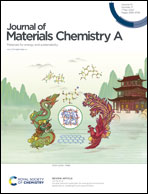Crystallinity modulation of donors by heteroatom side-chain engineering and solvent additive achieving 14.3% all-small-molecule organic solar cells†
Abstract
All-small-molecule organic solar cells (ASM-OSCs) have attracted considerable attention owing to their excellent batch-to-batch reproducibility. Herein, two new small molecules with alkoxyphenyl- and alkthiophenyl-substituted benzodithiophene (BDT) as the central building block named BDT-O and BDT-S were successfully synthesized and employed as donors in ASM-OSCs. With a single atom variation from O to S, the crystallization behavior of BDT-S was efficiently modulated, due to the difference of electron withdrawing ability between two atoms. Moreover, post-treatment is an effective method to influence morphology and crystallinity of the active layer for ASM-OSCs. The BDT-S:Y6-BO blend film, applied with the DIO additive, displayed a smoother surface, proper crystallinity, a more face-on preferred orientation and a better nano interpenetrating network phase separation morphology than that of the BDT-O:Y6-BO blend film, resulting in more effective and balanced carrier mobilities. Therefore, upon adding the DIO additive, the power conversion efficiency (PCE) of BDT-S- and BDT-O-based devices has reached 14.3% and 12.06% with a high short-circuit current density (JSC) of 25.14 mA cm−2 and 23.07 mA cm−2 and a fill factor (FF) of 68.3% and 64.02%, respectively. This work gives an effective strategy to modify side-chains for developing more effective small molecule donors.



 Please wait while we load your content...
Please wait while we load your content...